
The Real Reason Ancient Indo-Europeans Carried Out Human Sacrifice
The ultimate aim of the original Indo-European sacrifices, modelled after the cosmic sacrifice of the Purusha [a cosmic man whose sacrifice by the gods created all life] … must have been the liberation of the self from the illusions of the material fabric in which it is entangled and the direction of the energy of man into the divine consciousness.
The Proto-Vedic Ritual of Human Sacrifice – A Substitute for Self-Sacrifice?
This liberation is the principal aim of yogic ascesis as well, which is, as J.C. Heesterman has pointed out, an internalisation of the sacrifice. Since the primary purpose of a sacrifice is indeed that of self-sacrifice, the sacrifice of a human involved in the proto-Vedic Purushamedha [a Śrauta ritual of human sacrifice] must originally have been conducted as a substitute for a sacrifice of the sacrificer himself, since the sacrificer is, in all Vedic sacrifices, identified with the victim. As Heesterman states, “self-sacrifice is an all-but-ubiquitous theme in the ritual brāhmana texts, the victim as well as the other offerings being regularly equated with the sacrificer”. That is why the victim in the Purushamedha was originally exclusively a brāhman or a kshatriya, since only these two castes were qualified to act as representatives of the Purusha and to conduct sacrifices.
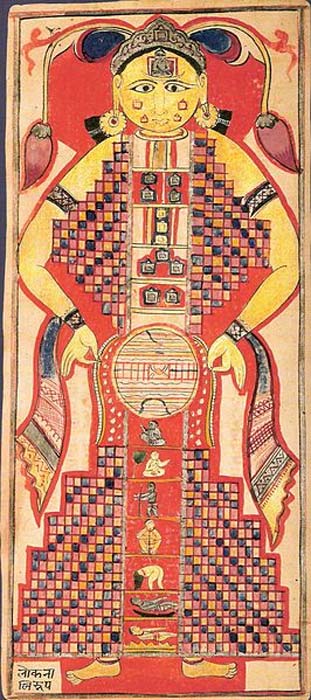
The Lokapurusha or ‘cosmic man’ (public domain).
The Phallic Force
At the same time, the sacrificial victim is always a male since only his energy can substitute for the phallic force of the Purusha that fills the universe with its life. We shall observe in our survey of the cosmological bases of sacrifices that the entire evolution of the material universe arises from repeated castrations, and preservations, of the divine phallus, first in the Ideal realm of the Purusha, then in the early cosmos of Brahman and, lastly, in the material universe, as the Tree of Life that arises from the underworld and extends to the heavens.
If what is most important in the Purusha is his phallic power, as is evident also in the Hesiodic account of the castration of Ouranos by Chronos, it is probable that the sacrifice originally focussed on the victim’s phallus, as we observe, for example, in the veneration of the penis of a slaughtered stallion among the ancient Nordic peoples. Similarly, in the Equus October ceremony in ancient Rome a race-horse was slaughtered and its tail (standing no doubt for its penis) was brought to the regia.
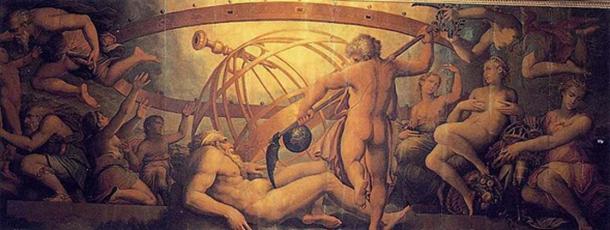
The castration of Ouranos by Chronos (public domain)
In ancient Egypt, the castration of Re is represented as a self-castration. Hu, intellectual expression, and his consort, Sia, intuition, are said in a New Kingdom commentary on the Book of the Dead to be "the blood which fell from the phallus of Re, when he was going to mutilate himself". Since the castration of Re corresponds to the castration of Anu in the Hurrian epic of the Kingship in Heaven, and the castration of Prajāpati by Shiva, we may assume that this event precedes the formation of the Cosmic Egg which, in the Purānas arises, from the seed of Prajāpati/Shiva. This may also have been the source of the practice noticed in some rituals of the Dionysiac religion that may have involved self-mutilation.
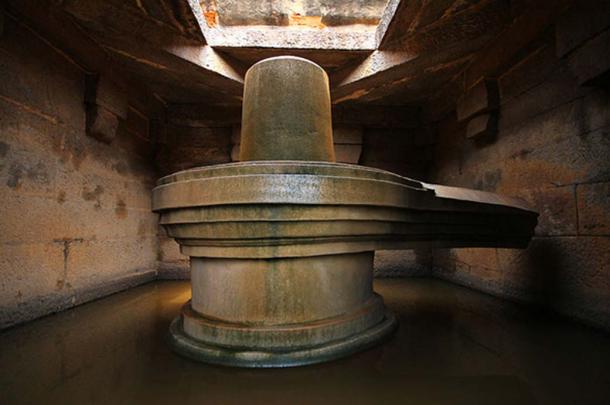
Linga Temple, Hampi (CC by SA 3.0). The Lingam represents the phallic power.
Sacrificed Animals Represented the Divine Phallus
Over time, however, the human victim was substituted with animals that equally represented the energy of the divine phallus, thus a horse or a bull, and finally with lesser animals such as sheep and goats. In all cases, however, the original significance of the sacrifice as a self-sacrifice is never forgotten, as many of the processes of the Vedic sacrifices as well as many of the accompanying Vedic chants reveal. The spiritual purpose of a sacrifice is indeed to control the sexual energy and convert it into spiritual energy directed to the attainment of the ideal “sattvic” state of the Purusha, that is, as the solar deity Vishnu.
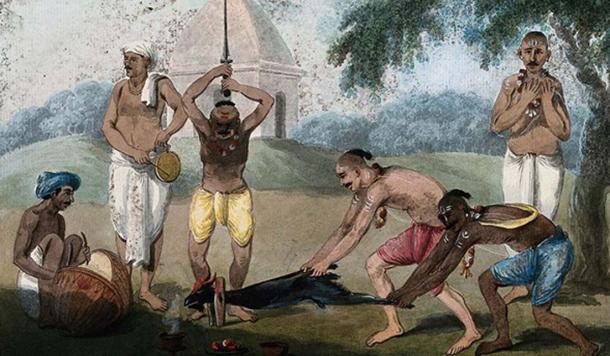
Over time, human victim was substituted with animals (Wellcome Library, London)
The Swallowing of the Divine Phallus
It will be noted further that the phallic sacrifice of the ideal Purusha is repeated in the manifest cosmos, for such a sacrifice is necessary for the transference of the divine power to our solar system. The second sacrifice involves the destruction of Brahman/Prajāpati by his son Ganesha (Zeus/Seth) and the swallowing of the divine phallus by the latter so that the whole universe and its light moves into his body.
Seth is seen, for instance in the Egyptian mouth-opening ritual, to have been castrated or killed, for a bull representing Seth is slaughtered and its thigh is used to revive the dead Osiris. In the town of Saka, Seth as a bull undergoes self-castration and, in the Pap. d’Orbiney, Seth (called Bata in Saka), castrates himself in order apparently to avoid the sexual advances of his sister-in-law, and then goes into exile in foreign lands. This is clearly the source of the rites of the Phrygian Attis rites mentioned in Lucian’s De Dea Syria. In the mouth-opening ceremony performed on divine statues, too, the “thigh” represents the divine genitals – which, according to the Orphic cosmogonies, Zeus (Seth) is said to have swallowed after they had been severed from Ouranos by Zeus’ father Chronos. So it is not surprising that Seth’s genitals (“thigh”) are brought forward to revive the moribund Osiris with its life and light. According to the series entitled ‘The Contendings of Horus and Set’, too, the conflicts between the two gods include the violation of Horus the Younger by Seth and the castration of Seth by Horus. All these incidents focus on the importance of the divine phallus now as the life of the emerging universe as well as its light.
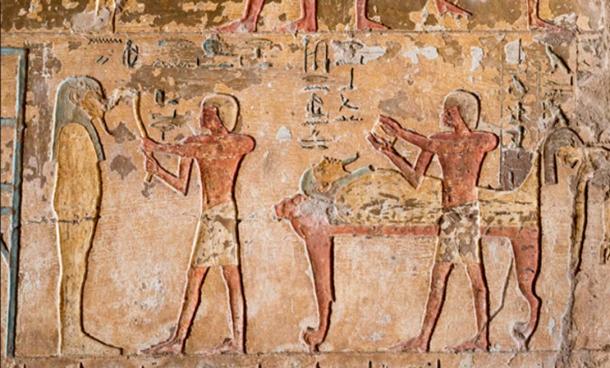
The Egyptian mouth-opening ceremony. Relief in the tomb of Renni (kairoinfo4u / flickr)
Transformation of the Solar Force
The transformations of the solar force that are recounted in the mythology are focussed within the fire that is worshipped in the Āryan rituals. Indeed, the Vedic texts reveal a more than scientific understanding both of the several forms of heat that pervade the human microcosm and of the different parts of the flames of external fire. Such an understanding is clearly not a result of contests conducted among warriors but of the supernatural yogic discipline that informed the religion of the brāhmans and identifies them not just as wise men but indeed as “magicians”. This is of course the reason why the term “magi” used for their Iranian counterparts has long been equated with “magicians”.
The Indo-European sacrifice was seen as important not only for the spiritual liberation of the sacrificer but also for the solar rebirth that it allows the sacrificer to undergo as a brāhman, or one who has realised the solar virtue of his soul, just as the death of Osiris is followed by his revival in our universe as the sun. In the Indian horse-sacrifice, ashvamedha, for instance, the horse represents the sun which has been lost and must be recovered. Thus SB XIII,3,1,1 declares:
Prajâpati's eye swelled; it fell out: thence the horse was produced; and inasmuch as it swelled (ashvayat), that is the origin and nature of the horse (ashva). By means of the Asvamedha the gods restored it to its place; and verily he who performs the Asvamedha makes Prajâpati complete, and he (himself) becomes complete; and this, indeed, is the atonement for everything, the remedy for everything.
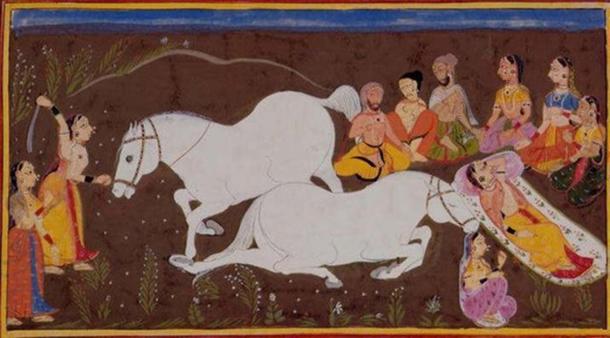
In the Indian horse-sacrifice, ashvamedha, the horse represents the sun which has been lost and must be recovered
This is the same significance that attaches also to the Osirian funereal rites, especially the mouth-opening ritual. For the assault on the solar force by Seth is referred to as the damage or robbing of the “Horus eye” [the sun] which must be restored to Horus the Elder/Osiris.
Belief in Spiritual Rebirth and Immortality
By performing a sacrifice, the sacrificer is able not only to achieve a spiritual rebirth but thereby also to overcome death itself and achieve immortality. As Heesterman remarked, “In the sacrifice are summed up the two opposite poles of the cyclical rhythm of the cosmos, birth and death, ascension and descent, concentration and dispersion”. And indeed it is sacrifice which renders the gods themselves immortal, that is, by realising their essential self as immortals. According to SB XI,2,3,6, “In the beginning, indeed, the gods were mortal, and only when they had become possessed of the Brahman they were immortal.” This was achieved through a focus on the vital fire within as well as without man. As SB II,22,8ff makes clear, at first the gods noticed that Agni the fire alone was immortal and so they sought, through austerities and eulogies, to implant the fire within themselves and thus became immortal themselves. We see that the immortal self that is to be realised is primarily related to that of fire, Agni. The sacrifice is also a means of sustaining the immortality of the gods so that the latter may in turn bless the human sacrificer with boons such as rain, food, wealth, etc.
Ultimately, as SB XIV,32,1 declares, “the sacrifice is the self of all beings and of all gods”. The sacrificer who performs the sacrifice to serve the external macrocosmic powers of the gods is called a devayājin. The sacrificer who is concerned exclusively with the self (ātman) is an ātmayājin ( SB XI,2,6,13). And, as Heesterman points out,
What distinguishes the self-sacrificer is his knowledge – the knowledge, that is, of the equivalence of ritual and self ... Thus, he is freed from his mortal body, from evil, and construes with Rg-, Yajur- and Sāmaveda and with oblations a transcendental body ... This transcendental body is no other than the ātman of the self-sacrificer, the erstwhile puruşa who no longer undergoes sacrifice but has mastered and integrated it.
Top image: The Purusha or ‘cosmic man’, which has a thousand heads and permeates the earth and universe in all directions. (In The Vedas)
References
J.C. Heesterman, “Reflections on the significance of the Daksina”, Indo-Iranian Journal 3 (1959), p.245.
Hesiod, Theogony, I, 170ff.
J. Mallory and D.Q. Adams, Encyclopedia of Indo-European Culture, p.330.
M. Sandman-Holmberg, The God Ptah, Lund: C.W.K. Gleerup, 1946, p.42.
H. te Velde, Seth God of Confusion : A Study of his Role in Egyptian Mythology and Religion, Leiden: E.J. Brill, 1967, p.41.
Lucian, De Dea Syria, The Syrian Goddess, tr. H.W. Attridge and R.A. Oden, Missoula, MT; Scholars Press, 1976, p.23).
Book of the Dead, Ch.113; see S. Mercer, Horus Royal God of Egypt, Grafton, MA: Society of Oriental
Research, 1942, p.74; cf. H. Te Velde, op.cit., p.58.
















Comments
This has to be some of the most useful and interesting information I've found. Really fascinating and helpful in my own research and experience of kundalini, the grail quest, and understanding the roots of patriarchy. Thank you Dr Alexander Jacob.
Michaela Clarke
I am skeptical. You make this sound so weird and sexually perverted. I am supposed to believe they sexually mutilated themselves then voluntarily sacrificed themselves?
From what very little I've ever seen on this subject, the sacrifices didn't seem voluntary. Mostly, I've seen accounts and illustrations of Celtic sacrifices which seemed to often involve people in wicker baskets sometimes set on fire, sometimes hung in trees. Nothing sexual.
Your references seem more middle eastern.